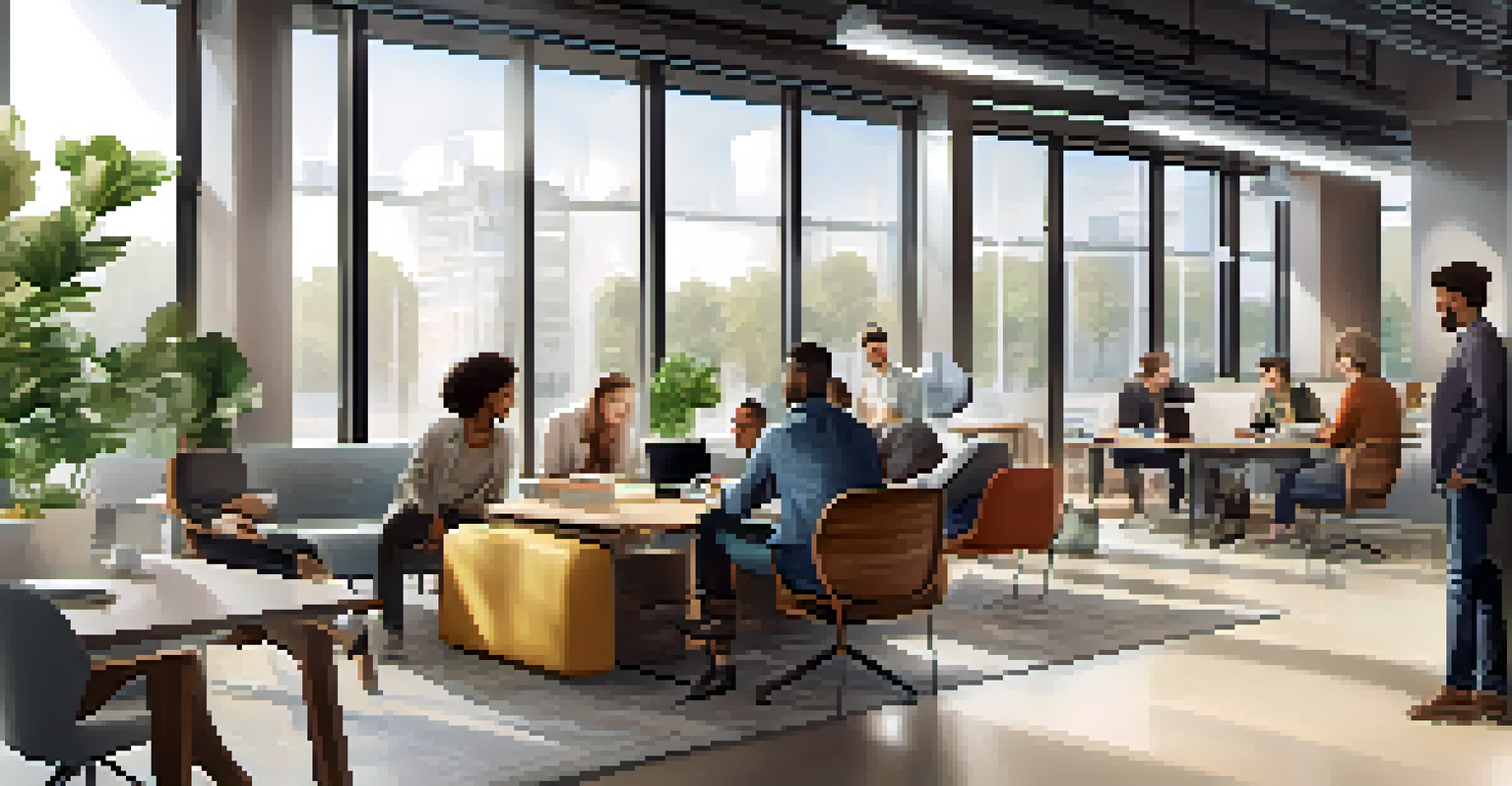Creating Accessible Workspaces at Home for All Needs

Understanding the Importance of Accessibility in Home Workspaces
Creating an accessible workspace at home is vital for everyone, as it ensures that all individuals can work comfortably and efficiently. Accessibility isn't just about physical space; it's about fostering an environment where everyone feels included and valued. By considering the diverse needs of individuals, we can create a more inclusive work culture right from our homes.
Accessibility allows us to tap into everyone’s potential, and that means creating an environment where all voices can be heard.
Think of accessibility like a bridge; it connects people with their work by removing barriers that might hinder their productivity. An accessible workspace can enhance creativity and focus, allowing everyone to thrive regardless of their physical abilities. This approach not only boosts morale but also promotes collaboration among team members who may have different needs.
Moreover, making accessibility a priority reflects a company's values and commitment to diversity. When employees see that their well-being is taken seriously, it fosters loyalty and motivation. An accessible workspace isn't just a trend; it's a necessary evolution in how we view work and inclusion in the modern world.
Assessing Individual Needs for Home Workspaces
The first step in creating an accessible workspace is understanding the unique needs of each individual. This can involve conversations with employees or family members about their specific requirements, which may include mobility aids, visual assistance, or even sensory-friendly elements. By gathering this information, you can tailor the workspace to cater to everyone’s needs.

Consider creating a simple checklist that identifies various accessibility features. This could range from adjustable desks and ergonomic chairs to proper lighting and soundproofing options. Each person’s needs can vary significantly, so it’s crucial to remain flexible and open-minded during this assessment phase.
Accessibility Boosts Productivity
Creating an accessible workspace enhances comfort and efficiency for all individuals, fostering a more inclusive work culture.
Ultimately, the goal is to ensure that everyone feels comfortable and empowered in their workspace. When individuals have a say in how their environment is set up, they are more likely to be engaged and productive. This collaborative approach can lead to thoughtful solutions that benefit everyone involved.
Designing Physical Spaces for Accessibility
When designing a physical workspace, layout is essential. Ensure that pathways are clear and that furniture is arranged to allow easy movement, especially for those using wheelchairs or crutches. Consider incorporating adjustable furniture that can accommodate various tasks and preferences, such as sit-stand desks.
The greatest disability is not having a disability, but having a disability that is not understood.
Lighting is another critical factor in creating an accessible workspace. Natural light can boost mood and productivity, but it’s also essential to have adjustable and adequate artificial lighting to reduce eye strain. Dimmers and soft lighting can help create a comfortable atmosphere for everyone.
Additionally, think about the colors and textures you choose. Calming colors can enhance focus, while tactile materials can provide comfort for those with sensory sensitivities. Remember, these design elements should not only serve a functional purpose but also contribute to an inviting and engaging workspace.
Incorporating Technology for Enhanced Accessibility
Technology plays a crucial role in creating accessible workspaces at home. Tools like voice recognition software, screen magnifiers, and text-to-speech applications can significantly aid those with disabilities. By leveraging these technologies, you empower individuals to perform their best work without unnecessary hindrances.
It's also important to ensure that all digital platforms used for work are accessible. This includes having websites and applications that comply with accessibility standards, allowing individuals with disabilities to navigate them easily. A user-friendly digital environment enhances the overall experience and productivity of all employees.
Tailor Spaces to Individual Needs
Assessing and accommodating the unique requirements of each person ensures that everyone feels comfortable and empowered in their workspace.
Don’t forget about communication tools as well. Video conferencing software with captioning options or chat features can help bridge gaps for those who are deaf or hard of hearing. Embracing technology in this way not only supports those with specific needs but also enriches collaboration among all team members.
Creating a Sensory-Friendly Workspace
A sensory-friendly workspace takes into account the various sensory needs of individuals. This can involve reducing noise through soundproofing materials or using noise-canceling headphones for those who may be easily distracted. Additionally, incorporating soft lighting and calming colors can create a soothing environment that fosters concentration.
Consider providing options for sensory stimulation, such as stress balls, fidget spinners, or textured materials. These elements can help individuals manage their focus and anxiety, ultimately leading to a more productive work atmosphere. A sensory-friendly environment can be a game-changer for those with sensory processing differences.
Finally, don’t underestimate the power of plants and natural elements. Introducing greenery into the workspace can enhance mood and reduce stress, creating a more welcoming environment. By acknowledging and catering to sensory needs, you promote well-being and engagement among all individuals.
Promoting Flexibility and Adaptability in Workspaces
Flexibility is key when designing an accessible workspace. This means being open to changing layouts, furniture, and tools as needed to accommodate the evolving requirements of individuals. A workspace that can adapt to various tasks and preferences fosters a sense of ownership and comfort for all users.
Consider offering multiple workspace options, such as quiet zones for focused work and collaborative areas for group projects. This adaptability allows people to choose what works best for them at any given moment, enhancing overall productivity. The more choices available, the more empowered individuals feel in their roles.
Ongoing Education on Accessibility
Promoting continuous learning about accessibility best practices fosters a culture of respect and collaboration among team members.
Regularly revisiting the workspace setup and soliciting feedback can also promote adaptability. By engaging in open dialogue about what’s working and what’s not, you can continuously improve the environment. This approach not only benefits individual needs but also encourages a culture of inclusivity within the organization.
Encouraging Ongoing Education and Awareness About Accessibility
Creating accessible workspaces isn't a one-time effort; it requires ongoing education and awareness. Providing training sessions for employees about accessibility best practices can foster a more inclusive environment. This helps everyone understand the importance of accessibility and how to support their colleagues effectively.
Consider sharing resources, articles, or webinars that highlight different aspects of accessibility and inclusion. Encouraging open discussions about these topics can promote empathy and understanding among team members. When everyone is informed, the entire workplace benefits from a culture of respect and collaboration.

Lastly, it’s essential to celebrate progress and share success stories. Acknowledging improvements and positive changes encourages a commitment to accessibility. By fostering a culture of learning and growth, you empower everyone to contribute to an inclusive workspace.